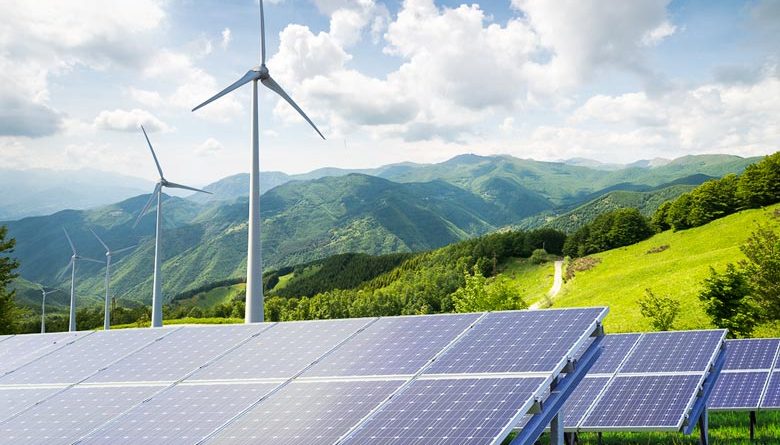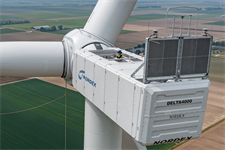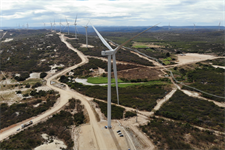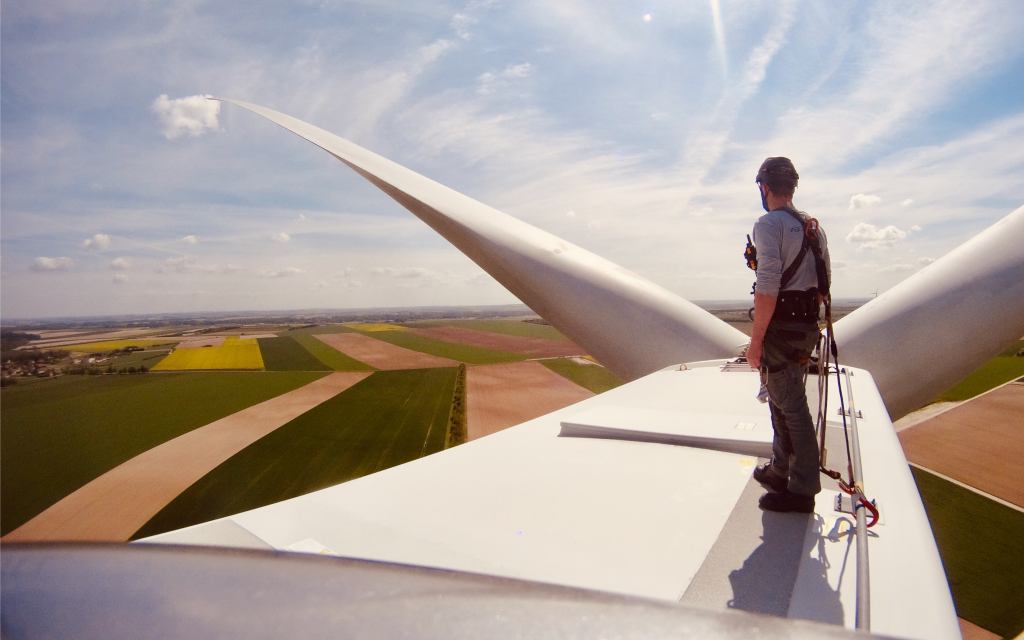Webinar recap: What you need to know from Solar 101
Energy Disrupter

After witnessing the success of the Wind 101 Webinar Series, I was eager to dive into the Solar 101 series. As mentioned in my recap of Wind 101, I am new to the renewable energy space and was ready to diversify my knowledge even more with this next installment of the 101 Webinar Series. Solar 101 covered topics ranging from residential and nonresidential solar PV demand to siting and permitting. The diversity of the topics covered, paired with the impressive speaker lineup, truly made Solar 101 a can’t miss event. If you couldn’t tune in to the event live, read on for a brief recap or download a recording here.
Part 1
Ryan Galeria, Vice President of Solar Development at sPower, amped up the audience for a great start to Solar 101 with a discussion on climate change, why this work is important, and the coming GreenWave. According to Ryan, “we are at a forefront for a revolution of energy and now is the best time to get involved”. This statement struck me because no matter what your knowledge level is when it comes to renewable energy, you have without a doubt heard about the current climate crisis. However, it made me excited to hear that change is afoot and we have the power to do something about it. In fact, averting a climate crisis may be very well within our control. With that, I am going to present a question to you that Ryan also asked during his presentation:
We have the tools to reverse this trend, but do we have the will?
Market Overview and Drivers for the U.S. Solar Energy Industry
Followed by Ryan, Molly Cox, Solar Research Analyst at Wood Mackenzie, presented on the solar market and various drivers for the industry. Molly’s discussion was the perfect introduction to the series and made even the newest members to the renewable energy space feel ready to tackle the next three days of the webinar. She walked the audience through insights on the differentiation between residential and nonresidential solar PV demand and even included a forecast for how COVID-19 will have an impact on demand. Included in Molly’s presentation were two graphics that depicted the pre and post COVID-19 impact on solar PV demand.

With the help of the graphic above as a visual, Molly explained the following:
- For the full year of 2020 the residential segment was heavily impacted by COVID-19. As a result, Wood Mackenzie expects a 25 percent decline for residential installation volumes in comparison to 2019.
- The residential segment is expected to pick back up in 2021.
- Regarding the nonresidential segment, there were significant project delays due to COVID-19 which are expected to cause a 38 percent decline.
Molly continued to discuss topics including utility scale segment, tariffs in the U.S. solar market, and mono facial vs. bifacial modules. After hearing Molly’s insights, my knowledge regarding solar had tripled and I was ready to learn about the financial aspects of solar next. Some key takeaways include:
- While the US utility scale market is dominated by tracker technology, as opposed to fixed tilt module mounting structures, these applications can provide a more competitive levelized cost of energy, especially when paired with bifacial modules.
- Higher efficiency modules will contribute to reduced system level costs, as a result of the comparatively fewer modules required.
Solar Project Finance and Investment
Next in part 1 of the Solar 101 Webinar Series, Paul Holshouser, Senior Director of Project Finance at Distributed Sun, discussed the financial aspects of a solar project. The finances behind developing a solar project seem daunting, but Paul walked the audience through all there is to know in an engaging yet effective manner. To help in his discussion, Paul divided the information up into two sections:
- Section 1: Project Development
- Section 2: Solar Project Finance
Section 1, project development, includes the activities before construction. Although this section entails a very complicated group of activities, Paul gave the audience a high-level summary which entails the following components:
- Analyze your market
- Get land control
- Carry out a host of activities: study the grid in which you want to interconnect to; power purchase agreement or offtake; permitting your land use and EPC (engineering procurement construction)
To further depict these activities, Paul also used the arrow graphic below to visually demonstrate what happens in the project development stage.

Section 1 also discussed development and operations in dollars. To demonstrate this topic to listeners, Paul included the following visual that represents $150 million of solar capital expenditure. The point being made here is that development requires smaller outlays in comparison to construction and project operations.

Next in section 2, Paul addressed all there is to know regarding solar project finance. To start out, Paul explained what exactly “Project Finance” is and described “finance-able” energy projects as having the following components:
- Predictable long-term cash flows
- Predictable operating environment
- Scale of operations to create a standalone business
Section 2 also included characteristics of tax equity. I thought it was interesting to learn that investors in large-scale solar need to have a very large tax liability – as in $100 million or more! Clearly, this means that no average Joe can be an investor in this space and investors are limited to very large U.S. financial institutions and select motivated corporations, such as Google.
To close section 2, Paul discussed solar in comparison to wind. Personally, this was my favorite part of Paul’s presentation because it allowed me to digest what I learned in Wind 101 and compare it to what I was learning in Solar 101. Although in both the solar and wind markets you are dealing with a lot of the same players and similar contracts, the key difference comes down to the tax equity market.
- Solar tax equity invests for five to six years to receive the Solar ITCS and depreciation deductions. Wind tax equity invests for 10 years to receive the wind PTC and depreciation deductions.
- Wind tax equity investors contribute more capital and require more cash distributions.
- Wind TEIs are subject to more operating risks through the PTC compared to the ITC.
- Regarding project debt, solar projects can achieve a lower DSCR than wind based on less variation in the solar resource, which increases potential borrowing.
Part 2
Siting, Permitting and Wildlife: Regional Differences
Michael Roberge, Managing Director at PEG Strategy, kicked off part 2 of the Solar 101 Webinar series with a discussion on regional differences in siting, permitting and wildlife. The topic that really piqued my interest during Michael’s discussion was the siting and environmental permitting considerations that must be made when identifying a project. Some of these considerations are:
- Grid availability
- Parcel size and shape
- Zoning
- Wetlands
- Wildlife
I was eager to learn more about wildlife considerations, because while grid availability or zoning may seem obvious, the need for wildlife regulations never occurred to me when it came to solar. As it turns out, only recently has the industry started to study solar-wildlife interactions. Some of the regulations that require mandatory compliance during the construction of a solar project include:
- Endangered Species Act
- Bald and Golden Eagle Protection Act
- Migratory Bird Treaty Act
To conclude this discussion, Michael brought to attention the importance of community engagement. As we all know, not everyone responds favorably to change. Therefore, public meetings are essential in the early stages of solar projects in order to develop that trust. Although smaller details such as transparency and communication with your community may be easier to neglect, they are just as vital to the success of a solar project as is compliance with environmental regulations.
Bifacial Modules and the Albedo Effect
Followed by Michael, Julie Chard, Product Director at GroundWork Renewables, first discussed what exactly bifacial modules are. Personally, I found this section to be very informative because I kept hearing the term “bifacial”, but I wasn’t entirely sure how these modules differed from others. It turns out, they are exactly what they sound to be. Bifacial modules produce solar power from both sides of the panel. They are characterized as having glass on the front and glass or a transparent polymer sheet on the back. There are three ways in which power is generated from bifacial modules, which are:
- Direct irradiance from the sun
- Diffuse irradiance
- Reflected irradiance
To visually depict bifacial modules, Julie included the following graphic.

After learning about bifacial modules, it was time to learn what albedo is and why it matters. At first albedo seems like a complex and confusing concept, but Julie breaks it down into understandable terms. Albedo is the proportion of the incident radiation that is reflected by a surface. It is expressed as a ratio between 0 (no reflection) and 1.0 (reflected radiation equal to incoming radiation) and can be calculated with the following equation: Reflected Horizontal Irradiance / Global Horizontal Irradiance.
Accurate albedo values are important to modeling solar power production, so Julie touched on sources of modeled and estimated albedo values and discussed how site-specific albedo measurements are made using instruments called albedometers.

To conclude her discussion, Julie circles back to bifacial modules and discusses the future of the technology. She addressed some challenges they face in utility-scale solar, such as:
- Standardized testing and performance certification
- Accurate and standardized modeling
- Financing
Despite those challenges, bifacial market share has grown continuously. Some positive trends that we are seeing in the market are:
- Increasing module production and technology adoption
- Decreasing cost per watt
- Maximizing bifacial gains: increasing module efficiencies, optimizing array layouts and tracking, and increasing albedo with ground cover treatments
Each of these factors contributes to achieving a lower than ever levelized cost of energy.

Part 3
Transmission and Delivery
Jennifer Tripp, Managing Director in Transmission and Delivery at nFront Consulting, kicked off the final section of the Solar 101 Webinar Series with a presentation on transmission and delivery. Jennifer started by informing the audience on critical aspects for selecting a site for your project. There’s much more to developing a successful solar project than finding the perfect spot, other areas of importance include:
- Understanding the market structure and your level of competition
- Renewable resource penetration
- Integration of renewables: transmission availability
- Transmission expansion
- Depth (and lag time) of queue
Next, Jennifer discussed transmission. She did an excellent job breaking down this topic and explained the role of transmission as the highway network to get individual projects to the end user. Although transmission balances several different aspects, the overarching aspect boils down to reliability. It’s important to note, that upgrades to transmissions can be numerous, costly and take years to build. However, these challenges can be met:
- Know the market
- Consider competition in the region
- Develop/consider relationships with off takers
Solar + Storage 101
To wrap up the Solar 101 Webinar Series, Ray Saka, Senior Director of Sales at IHI Energy Storage, discussed solar and storage as a unified source. I was interested to learn that it is no longer one or the other; it’s the merging of the two. Ray offered listeners an insightful overview of solar and storage and then dove into more detail such as system design. Some of my key takeaways regarding system design are:
- System modeling directly linking to kW/kWh sizing to revenue is important
- Project and design specific modeling is key – it is a very complex process that needs to be done in order to design the system that is optimal to the project
Although topics in this section such as battery selection and power plant controls seem very complicated, Ray broke down each topic in an effective yet informative manner so that all listeners, no matter their knowledge level, would be able to follow along. For example, as a battery degrades the characteristics of the voltage condition changes. As a result, there are some problems that arise when new and old batteries mix.
- With higher internal resistance on the old racks, the current will flow more to the newer racks potentially causing over current issues
- Old and new racks will charge/discharge unevenly and rack to rack balancing will be disturbed
These potential problems are depicted in the following graphic:

Conclusion
With the conclusion of Solar 101, I am much more knowledgeable about the entire realm of renewable energy. Ryan Galleria told the audience at one point during the webinar that technology is a tool, but which solution will save the world? It turns out, there isn’t one solution; the solution to carbon free energy needs to be a mix of technology. With the technology that is currently being implemented and the technology being developed, this change will be here sooner than we know it. However, it is our responsibility to share this knowledge. For me, the 101 Webinar Series was the perfect place to start.
AWEA’s upcoming webinar lineup includes Offshore Wind, a wind workforce series and a series dedicated to helping you become the best leader you can be!
Original Source: https://www.aweablog.org/webinar-recap-what-you-need-to-know-from-solar-101/
















